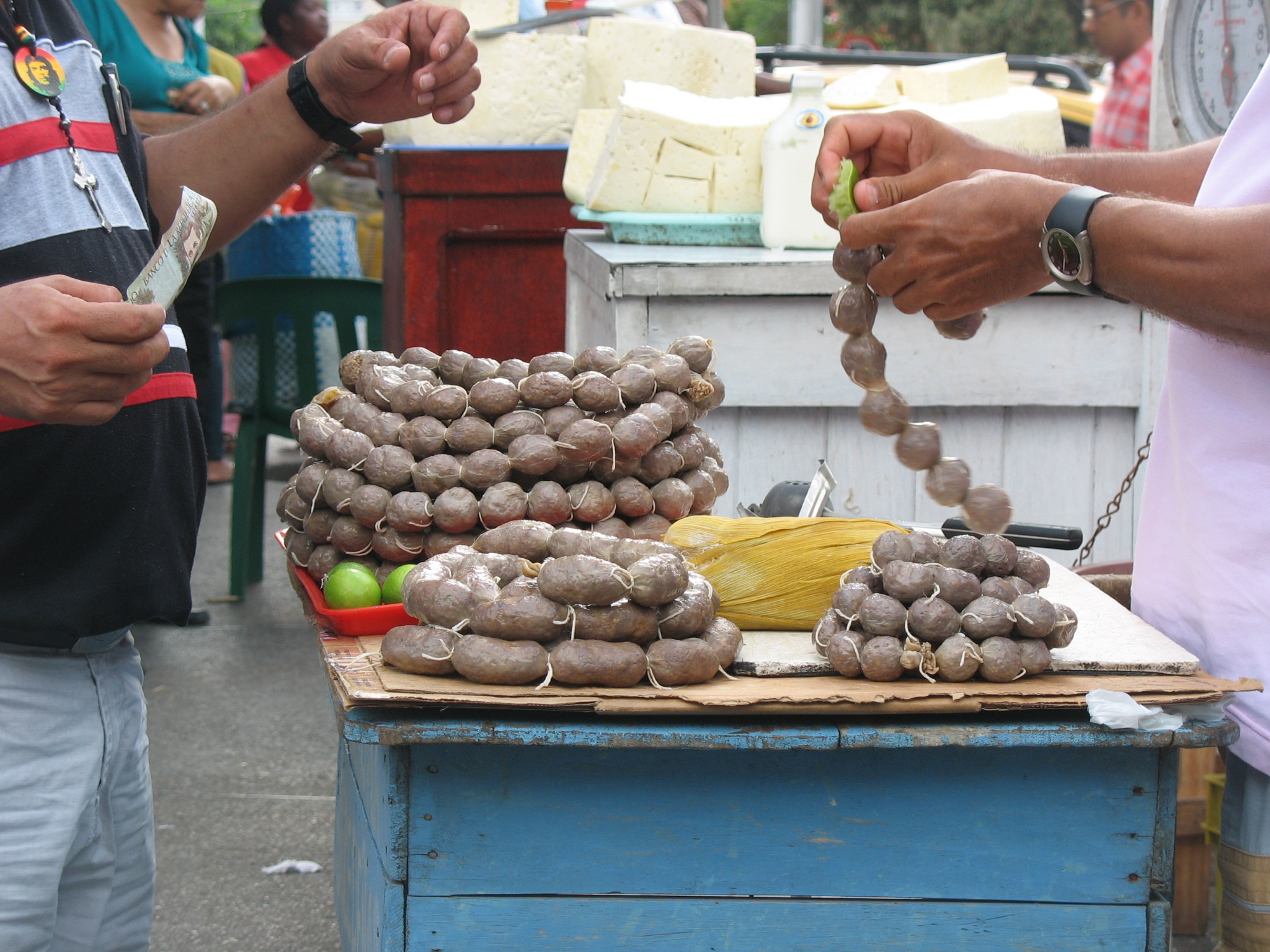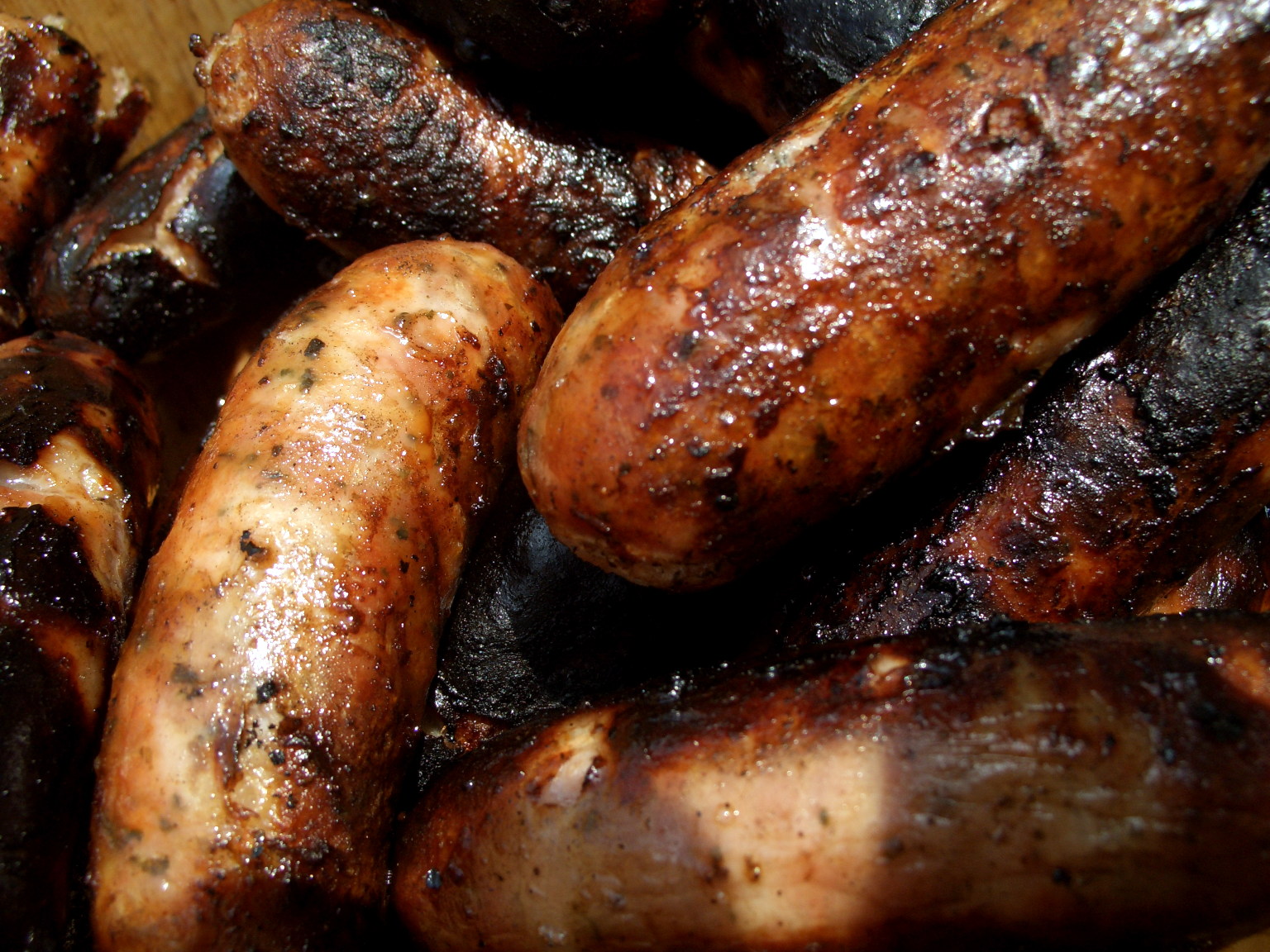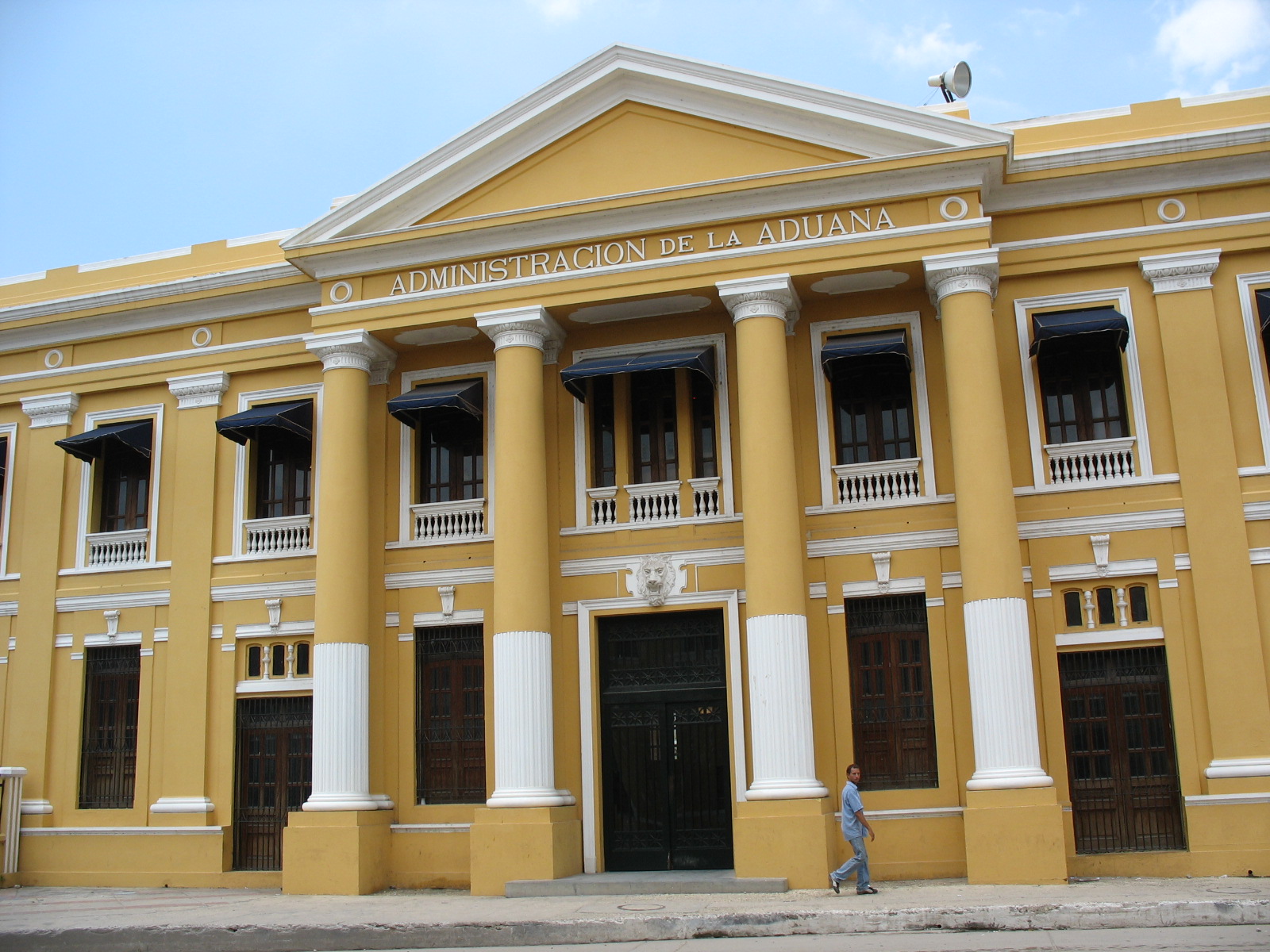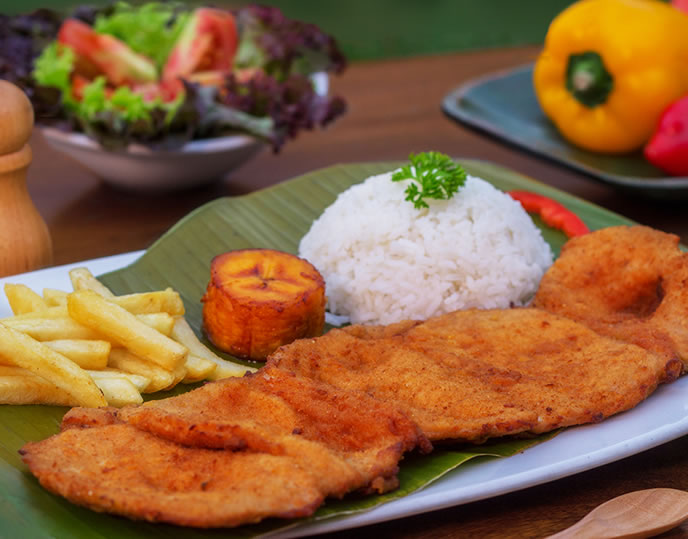|
Butifarra Soledeñas
Butifarra Soledeña (sausage of Soledad, Atlántico) is a type of botifarra that has developed into a regional specialty in Colombian cuisine. It is made from ground beef and pork with seasoning and spices. The meat is cut into pieces and boiled. The mixture is encased in intestine and tied off with string into sections. The lengths are boiled. Butifarras Soledeñas are hawked in the street by vendors calling out "buti, buti, buti" while drumming on the metal containers from which they are sold. Butifarras Soledeñas are often offered with fresh squeezed lime juice. The South American version of botifarra is shorter and almost round. It is a speciality in Colombia in the town of Soledad and also in Barranquilla. Butifarra is a very popular dish eaten with bollo of yuca and lime juice. It is a celebrated tradition of the area. It can be eaten with the casing removed. The name comes from the words ''embutido'' (Spanish for cured sausages and meaning stuffed) and ''farra'' (meaning ... [...More Info...] [...Related Items...] OR: [Wikipedia] [Google] [Baidu] |
Soledad, Atlántico
Soledad () is a municipality in the Colombian department of Atlántico, part of the metropolitan area of Barranquilla. It is 6th in population in Colombia and 3rd in the Caribbean region, after Barranquilla and Cartagena. It is also the city with the highest population growth in Colombia and in 2005 was 455,734 and 2019 683,486. On October 25, 2015 Joao Herrera Iranzo was elected by popular vote as the new mayor of Soledad. Limitations Bordered on the north by the special district of Barranquilla, where the boundary is the Arroyo Don Juan, on the south by Malambo, on the east with the Department of Magdalena, separated by the Magdalena River, and on the west by Galapa. Geography Physical Description: The location of the municipality of Soledad in relation to geographical coordinates is as follows: 10°55'N and 74°46'W. Transportation *Ernesto Cortissoz International Airport Ernesto Cortissoz International Airport ( es, Aeropuerto Internacional Ernesto Cortissoz, ) ... [...More Info...] [...Related Items...] OR: [Wikipedia] [Google] [Baidu] |
Bollo
Bollo is a bun, popular in Latin America, made from corn, yuca or potato. Variations are eaten in Colombian cuisine, Cuban cuisine ( Tamal de maíz solamente ) and Panamanian cuisine. Corn and yuca bollos are an indigenous food of the Caribbean coast of Colombia and Panama, where they are boiled in leaves. This preparation is similar to the humita of the Andes, the hallaquita of Venezuela and the pamonha of Brazil. In Colombia, bollos are sold by street vendors along the Colombian coast, as well as in stores and supermarkets. They are primarily served for breakfast as an accompaniment with cheese. Panamanian bollo has been described as a type of tamale. File:Bollo Maimón-Salamanca.JPG, Bollo Maimón-Salamanca File:Bollo limpio.jpg, Bollo File:Bollos (Requena).jpg, Bollos Requena File:Bollo de mazorca.jpg, Bollo of Mazorca File:Bollo de angelito.jpg, Angelito bollo See also * List of maize dishes This is a list of maize dishes, in which maize (corn) is used as a primary ... [...More Info...] [...Related Items...] OR: [Wikipedia] [Google] [Baidu] |
Botifarra
''Botifarra'' ( es, butifarra; french: boutifarre) is a type of sausage and one of the most important dishes of the Catalan cuisine. ''Botifarra'' is based on ancient recipes, either the Roman sausage ''botulu'' or the ''lucanica'', made of raw pork and spices, with variants today in Italy and in the Portuguese and Brazilian ''linguiça''. In Colombia, ''Butifarras Soledeñas'' are a popular tradition in Soledad, Atlántico. Varieties Some of the most representative types are: *Raw botifarra, ''botifarra vermella'', ''butifarra roja'', ''butifarra cruda'', ''botifarra crua'', or ''roget''. It is also known as ''llonganissa'' or ''longaniza'' in many places of the Eastern Spain. This botifarra is usually grilled or barbecued. *Black botifarra, ''butifarra negra'' or ''negret'', containing boiled pork blood in the mixture. *''Botifarra catalana'', large botifarra similar to cooked ham; it may contain truffles. *''Botifarra d'ou'' or ''butifarra de huevo'' (literally "botifarra ... [...More Info...] [...Related Items...] OR: [Wikipedia] [Google] [Baidu] |
Suero Atollabuey
Suero, also referred to as suero costeño or suero atollabuey, is a fermented-milk-based condiment from Colombia's Caribbean coastal region. It is somewhat similar to yogurt or sour cream. It is served as an accompaniment for various dishes and snacks. It is believed to be introduced by Arab Colombians, as a local adaptation of labneh. Arroz de lisa 2 - Barranquilla.jpg, Arroz de lisa (mullet rice) from Barranquilla served in bijao leaf with cooked yuca, a triangle of costeño cheese and a sauce of suero atollabuey. Suero costeño.jpg, A bottle of suero costeño in foreground and costeño cheese in background at a market stand in Barranquilla. See also *Colombian cuisine * Queso costeño *Arroz de lisa * Butifarra Soledeñas *Bollo *Jocoque Jocoque or jocoqui is a Mexican dairy product based on fermented milk, from uncertain origins, influenced by Lebanese cuisine. Characteristics Jocoque is a food produced from a milk base which, in its most artisanal form, is obtained b ... [...More Info...] [...Related Items...] OR: [Wikipedia] [Google] [Baidu] |
Arroz De Lisa
Arroz de lisa (mullet rice) is a traditional Colombian cuisine dish from the Atlantic (Caribbean Sea) coast. It is cooked with mullet, a sea fish found in brackish waters, like those at river mouths. In addition to the mullet which are usually dried and salted previously, the rice contains vegetables (e.g., onion, ají dulce, onion), and spices (e.g., paprika, cumin, salt, pepper). It is usually served in a leaf with minced chives, accompanied by bollo, avocado salad, and guarapo. See also * List of rice dishes * Queso costeño * Suero atollabuey * Butifarra Soledeñas *Bollo Bollo is a bun, popular in Latin America, made from corn, yuca or potato. Variations are eaten in Colombian cuisine, Cuban cuisine ( Tamal de maíz solamente ) and Panamanian cuisine. Corn and yuca bollos are an indigenous food of the Caribbe ... References Colombian cuisine Latin American rice dishes https://www.tasteatlas.com/arroz-de-lisa {{Colombia-cuisine-stub ... [...More Info...] [...Related Items...] OR: [Wikipedia] [Google] [Baidu] |
Queso Costeño
Queso (Spanish for "cheese") may refer to: * Chile con queso, a cheesy sauce * Queso Records * Queso blanco, a white cheese * Queso Chihuahua * Queso flameado * an obsolete TCP/IP stack fingerprinting tool that was well known in the late 1990s * Queso, a character from ''The Lingo Show'', a kids' TV show * "Queso", a 2015 song by Lil Uzi Vert from the album ''Luv Is Rage ''Luv Is Rage'' is the debut commercial mixtape by American rapper Lil Uzi Vert. It was released on October 30, 2015, by Generation Now and Atlantic Records. The mixtape includes features from Young Thug and Wiz Khalifa. A sequel was released on ...'' {{disambig ... [...More Info...] [...Related Items...] OR: [Wikipedia] [Google] [Baidu] |
Bollo
Bollo is a bun, popular in Latin America, made from corn, yuca or potato. Variations are eaten in Colombian cuisine, Cuban cuisine ( Tamal de maíz solamente ) and Panamanian cuisine. Corn and yuca bollos are an indigenous food of the Caribbean coast of Colombia and Panama, where they are boiled in leaves. This preparation is similar to the humita of the Andes, the hallaquita of Venezuela and the pamonha of Brazil. In Colombia, bollos are sold by street vendors along the Colombian coast, as well as in stores and supermarkets. They are primarily served for breakfast as an accompaniment with cheese. Panamanian bollo has been described as a type of tamale. File:Bollo Maimón-Salamanca.JPG, Bollo Maimón-Salamanca File:Bollo limpio.jpg, Bollo File:Bollos (Requena).jpg, Bollos Requena File:Bollo de mazorca.jpg, Bollo of Mazorca File:Bollo de angelito.jpg, Angelito bollo See also * List of maize dishes This is a list of maize dishes, in which maize (corn) is used as a primary ... [...More Info...] [...Related Items...] OR: [Wikipedia] [Google] [Baidu] |
Cassava
''Manihot esculenta'', common name, commonly called cassava (), manioc, or yuca (among numerous regional names), is a woody shrub of the spurge family, Euphorbiaceae, native to South America. Although a perennial plant, cassava is extensively cultivated as an annual agriculture, crop in tropical and subtropical regions for its edible starchy tuberous root, a major source of carbohydrates. Though it is often called ''yuca'' in parts of Spanish America and in the United States, it is not related to yucca, a shrub in the family Asparagaceae. Cassava is predominantly consumed in boiled form, but substantial quantities are used to extract cassava starch, called tapioca, which is used for food, animal feed, and industrial purposes. The Brazilian farinha, and the related ''garri'' of West Africa, is an edible coarse flour obtained by grating cassava roots, pressing moisture off the obtained grated pulp, and finally drying it (and roasting both in the case of farinha and garri). Cassav ... [...More Info...] [...Related Items...] OR: [Wikipedia] [Google] [Baidu] |
Barranquilla
Barranquilla () is the capital district of Atlántico Department in Colombia. It is located near the Caribbean Sea and is the largest city and third port in the Caribbean Coast region; as of 2018 it had a population of 1,206,319, making it Colombia's fourth-most populous city after Bogotá, Medellín, and Cali. Barranquilla lies strategically next to the delta of the Magdalena River, (originally before rapid urban growth) from its mouth at the Caribbean Sea, serving as a port for river and maritime transportation within Colombia. It is also the main economic center of Atlántico department in Colombia. The city is the core of the Metropolitan Area of Barranquilla, with a population of over 2 million, which also includes the municipalities of Soledad, Galapa, Malambo, and Puerto Colombia. Barranquilla was legally established as a town on April 7, 1813, although it dates from at least 1629. It grew into an important port, serving as a haven for immigrants from Europe, espe ... [...More Info...] [...Related Items...] OR: [Wikipedia] [Google] [Baidu] |
Colombia
Colombia (, ; ), officially the Republic of Colombia, is a country in South America with insular regions in North America—near Nicaragua's Caribbean coast—as well as in the Pacific Ocean. The Colombian mainland is bordered by the Caribbean Sea to the north, Venezuela to the east and northeast, Brazil to the southeast, Ecuador and Peru to the south and southwest, the Pacific Ocean to the west, and Panama to the northwest. Colombia is divided into 32 departments and the Capital District of Bogotá, the country's largest city. It covers an area of 1,141,748 square kilometers (440,831 sq mi), and has a population of 52 million. Colombia's cultural heritage—including language, religion, cuisine, and art—reflects its history as a Spanish colony, fusing cultural elements brought by immigration from Europe and the Middle East, with those brought by enslaved Africans, as well as with those of the various Amerindian civilizations that predate colonization. Spanish is th ... [...More Info...] [...Related Items...] OR: [Wikipedia] [Google] [Baidu] |
Intestine
The gastrointestinal tract (GI tract, digestive tract, alimentary canal) is the tract or passageway of the digestive system that leads from the mouth to the anus. The GI tract contains all the major organs of the digestive system, in humans and other animals, including the esophagus, stomach, and intestines. Food taken in through the mouth is digested to extract nutrients and absorb energy, and the waste expelled at the anus as feces. ''Gastrointestinal'' is an adjective meaning of or pertaining to the stomach and intestines. Most animals have a "through-gut" or complete digestive tract. Exceptions are more primitive ones: sponges have small pores ( ostia) throughout their body for digestion and a larger dorsal pore (osculum) for excretion, comb jellies have both a ventral mouth and dorsal anal pores, while cnidarians and acoels have a single pore for both digestion and excretion. The human gastrointestinal tract consists of the esophagus, stomach, and intestines, and is ... [...More Info...] [...Related Items...] OR: [Wikipedia] [Google] [Baidu] |
Colombian Cuisine
Colombian cuisine is a compound of the culinary traditions of the six main regions within Colombia (Pacific, Amazonian, Andean, Orinoco, Caribbean, and Insular). Colombian cuisine varies regionally and is particularly influenced by Indigenous Colombian, Spanish, and African cuisines, with slight Arab influence in some regions. Furthermore, being one of the most biodiverse countries in the world, Colombia has one of the widest variety of available ingredients depending on the region. History of Colombian food Colombian food is a unique blend of indigenous and European traditions with a strong Afro-Caribbean influence. The two largest indigenous groups prior to European conquest were the Tairona, who lived along the Caribbean coast, and the Muisca, who lived in the highlands to the South. Arepas, made from ground corn, are one of the oldest cooked dishes in Colombian cuisine. It is believed that the name derives from the word for corn in the Chibcha languages. Arepas are a popul ... [...More Info...] [...Related Items...] OR: [Wikipedia] [Google] [Baidu] |






